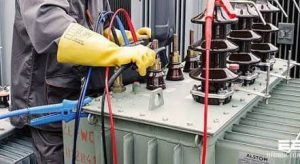 Transformer insulation testing is a critical maintenance activity to assess the condition of the insulation system inside a power or distribution transformer. Insulation deteriorates over time due to electrical, thermal, mechanical, and environmental stresses. Regular testing helps in preventing failures, extending equipment life, and ensuring reliable operation.
Transformer insulation testing is a critical maintenance activity to assess the condition of the insulation system inside a power or distribution transformer. Insulation deteriorates over time due to electrical, thermal, mechanical, and environmental stresses. Regular testing helps in preventing failures, extending equipment life, and ensuring reliable operation.
A Megger tests the basic overall insulation of the system in resistance in megohms of the transformers winding through its connection points. It is one measure of the transformers overall health. In addition to this we also do a TTR test which looks at all three phases and establishes whether there are any shorts between the phases.
Main Goals of Transformer Insulation Testing:
-
Evaluate insulation integrity and aging
-
Detect moisture ingress or contamination
-
Identify insulation breakdown risks
-
Determine suitability for continued operation
Common Transformer Insulation Tests
1. Insulation Resistance (IR) Test
-
Tool Used: Megger (Insulation Resistance Tester)
-
Voltage Applied: Typically 500V, 1000V, 2500V, or 5000V DC
-
Purpose: Measures resistance between windings and ground or between windings
-
Result: Measured in MΩ (Megaohms)
Test Connections:
-
HV to LV
-
HV to Ground
-
LV to Ground
Acceptable values vary, but generally > 100 MΩ is desirable depending on transformer size and voltage class.
2. Polarization Index (PI) Test
-
Derived From: Two insulation resistance readings (at 1 minute and 10 minutes)
-
Formula: PI = IR at 10 min / IR at 1 min
-
Interpretation:
-
PI > 2: Good
-
PI 1–2: Marginal
-
PI < 1: Poor (Possible moisture or contamination)
-
Used mainly for dry-type and power transformers.
3. Dielectric Dissipation Factor / Power Factor (Tan Delta) Test
-
Measures: Leakage current and insulation losses (AC)
-
Tool Used: Power Factor Test Set (e.g., Doble)
-
Frequency: Usually 50/60 Hz
-
Result: Percentage (%)
Interpretation:
-
Tan δ < 0.5%: Good insulation
-
Tan δ > 1%: Deteriorating insulation
-
High values suggest contamination or aging
4. Dielectric Breakdown Voltage (BDV) Test of Oil
-
Applies To: Liquid-filled transformers (mineral oil or ester)
-
Purpose: Checks insulating oil strength
-
Result: kV (Kilovolts) at breakdown
-
Standard: Should withstand ~30–40 kV for 2.5 mm electrode gap
Contaminated oil (moisture or particles) reduces dielectric strength.
5. Sweep Frequency Response Analysis (SFRA)
-
Purpose: Detects mechanical movement of windings, core faults
-
Indirect Insulation Test, but helps identify winding deformation which affects insulation clearance
6. Capacitance and Excitation Current Test
-
Purpose: Detect winding displacements or short circuits
-
Capacitance Changes: Can indicate insulation breakdown or contamination
Recommended Test Schedule
-
New Transformer: Before commissioning
-
In-Service Transformer: Every 1–3 years depending on voltage class and criticality
-
After Repairs or Relocation: Always test before energizing

